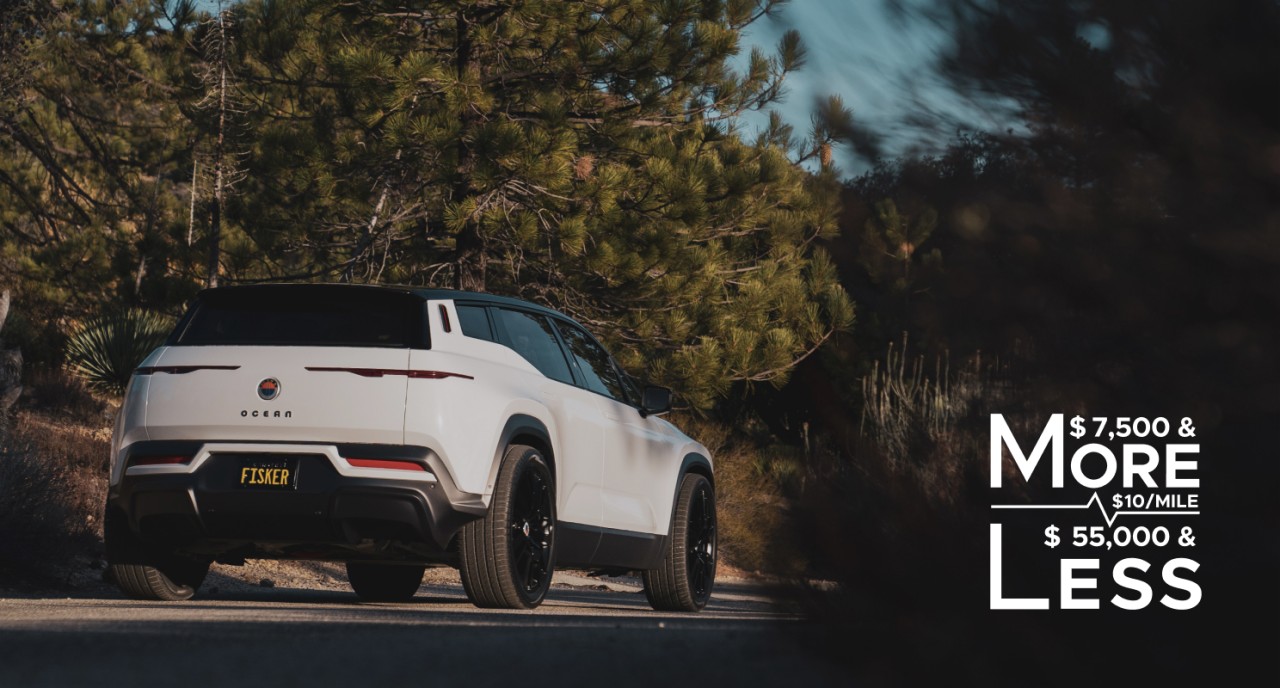
A Call to Action: 75 And More for 55 And Less
The U.S. government recently released its legislative priorities, including federally funded point-of-sale rebates when purchasing a battery electric vehicle (BEV). A rebate applied at the time of the transaction is a vast improvement over the current program of a $7,500 federal tax credit for both BEV and plug-in hybrid vehicles (PHEVs).
We are witnessing a rapid and sweeping change in mobility, with adoption of BEVs across the world, with several countries planning an outright ban of gasoline vehicles as early as 2025. It is imperative that America stays ahead in the race for BEV technology and development. Further, our automotive industry can only survive if it is globally competitive, and that starts by being successful in our own market, growing our brands and ultimately creating more jobs.
Fisker calls upon the federal government to implement “75 And More for 55 And Less” a rebate of $7,500 plus $10.00 per mile of certified driving range for BEVs priced at $55,000 and less. All rebates would be applied at the time of sale, instead of waiting for a tax credit.
For example, an electric vehicle priced at $45,000 powered by a certified 300-mile range battery will receive a point-of-sale rebate of $7,500 and more - an additional $3,000 for the battery range for a total of $10,500, lowering the transaction price to $34,500.
This plan would improve access to BEVs for more car buyers and encourage automakers to focus development efforts on more affordable zero emission vehicles. These incentives support households and small businesses by making clean mobility more financially accessible.
But just as important, creating demand for clean technology demonstrates America’s ability to lead by example, encouraging development of sophisticated automotive technology, including smarter cars and safer mobility, by innovative American entrepreneurs for use in vehicles across the world. Propulsion is changing; America must and can be on the forefront of that change.
We at Fisker are proving that leadership with the Fisker Ocean, due out in Q4 next year. The Ocean is being designed and developed at our creative studio, engineering center, and corporate headquarter locations in California. We also recently announced plans to bring a sub-$30,000 vehicle to the global market by the end of 2023.
But make no mistake: these incentives are not about promoting one company.
These incentives are about keeping America at the forefront of innovation and creativity worldwide while maintaining our domestic independence from imported sources of energy such as foreign oil. It is about supporting the creation of American jobs in the clean energy and mobility industries, including engineering, battery technology, and artificial intelligence, developing new concepts domestically for globally appealing products.
Historically, the $7,500 government incentive on electric vehicles, capped at 200,000 units per manufacturer, merely served to reward affluent early adopters with the motive and the means to purchase the latest technology. Ironically, buyers of more affordable BEVs from some companies are no longer eligible for the federal tax credit, just as the industry is on the cusp of offering even more appealing mainstream vehicles to the masses.
I am all for rewarding early adopters; they further Fisker’s vision of a cleaner future for all. But there are only so many people who can afford the many $70,000 plus BEVs coming to market over the next several years. Therefore, the next round of subsidies must focus on encouraging manufacturers to develop and launch more affordable BEVs, as well as incentivize mainstream buyers with clean energy vehicles which suit their wants and needs, even on a budget.
While a $55,000 vehicle may still be well out of reach of many Americans, a dual-pronged rebate such as “75 And More For 55 And Less” means a $55,000 BEV with 350 miles of range transacts at $44,000— a $4,000 gap from the $40,000 average price of a gas-powered vehicle.
With annual fuel savings of about $1,000 for a BEV, that gap is fully closed within four years of ownership. Many states and municipalities offer additional incentives, plus free or lower toll rates, free parking, and incentives for home chargers, further improving the payback period.
The plan to invest $100 billion in full battery electric vehicle subsidies must encourage adoption of vehicles without gas or petrol engines. Recent studies found plug-in hybrid electric vehicles (PHEVs) with gas engines emit far more greenhouse gas (GHG) and CO2 in real-world driving than in government testing as many consumers are fueling up the gas engine to drive, not recharging the electric battery. If rebates average $10,000, the $100 billion investment would support the purchase of 10 million clean energy battery electric vehicles, more than ten times the amount sold in the last ten years.
In the 1940sand 1950s, it was forward-looking government policies that created the freeway system and associated infrastructure to support the widespread ownership of private automobiles. Fast forward to today, the “75 and more for 55 and Less” campaign similarly champions America’s commitment to lead through innovation, technology, and design on a global basis, while generating job creation and investments on a local level. It is an ideal blend of the government supporting American ingenuity at home for use around the world, keeping America at the forefront of this mobility revolution.
Henrik, thanks for sharing!
Co-Founder in ANODA | We build consistent digital experience for apps
2yHenrik, thanks for sharing!
SVP Sales & Delivery | Customer Success & Experience Expert
2yHow much for a lease? Will you offer Sign & Drive no money down like VW Atlas Cross Support